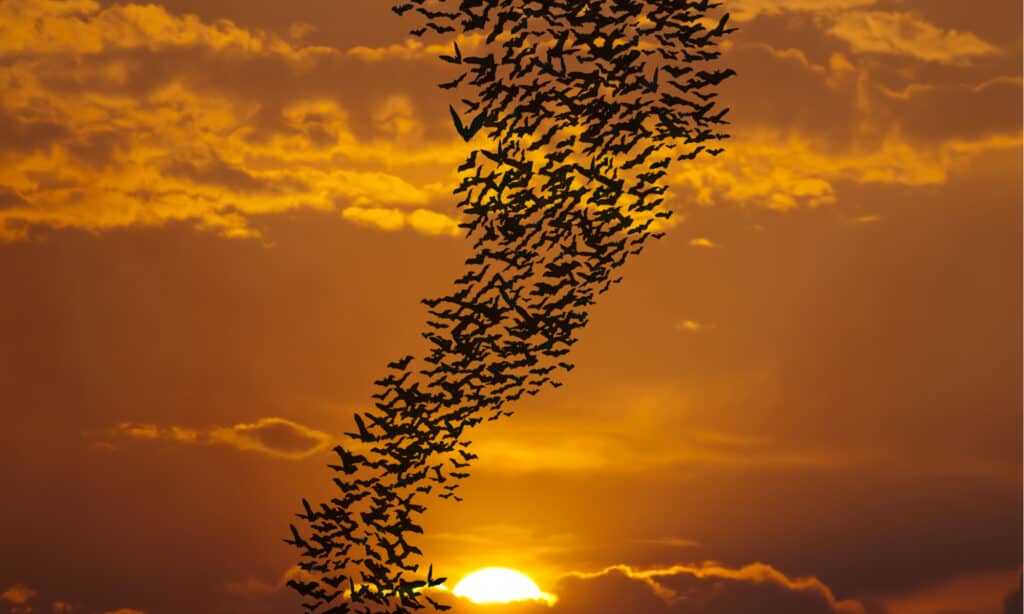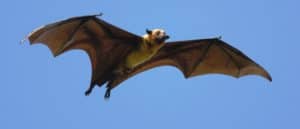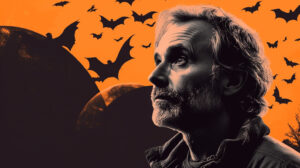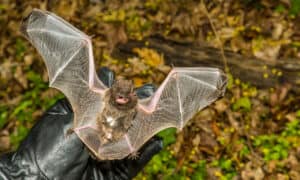Just in time for Halloween, we are here to talk about bats. Not just any bats, but human-sized bats! These bats have become a viral success, and now everyone is dying to know if the giant bats are real or hoax. Much is known about the flying mammals that almost everyone seems to fear. They do carry some diseases, but humans carry many more, and here we are walking around thinking all creatures love or fear us.
Let’s delve into what bats are and if we should fear them. More importantly, let’s find out if there is any truth to the human-sized bats that have taken the internet by storm.
What We Know About Bats

For centuries, humans have feared bats, though it is not the fault of the bats who are merely doing what bats do.
©Sarun T/Shutterstock.com
Bats fill our night skies with high-pitched chirps and eat our mosquito population when we allow. They are amazing creatures who look like a bird and small mammals combined in a Frankenstein-type way. Bats have appeared in almost every vampire movie made and certainly show up on spooky Halloween nights. Anything with a creepy, ghastly, scary, or spooky vibe generally has at least a few bats along for the ride. But what are bats?
Bats are small to medium-sized furred mammals with wings that belong to the order Chiroptera. Overall, there are two different types of bats, microbats and megabats. Almost all bats are microbats. These are the bats you see flying radically around the night sky, diving like acrobatic jets around streetlights. Those crazy flyers are using echolocation to find their way around, and they aren’t flying erratically; they are chasing insects.
Mosquito-Eating Champions of the World
The tiny ominous creatures of the night aren’t swarming around streetlights to terrify you and your friends. They are going where the insect buffet is; in the light. As they say, like a moth is drawn to a flame. Those moths love streetlights, porch lights, flames, and pretty much any other type of light available. The moths are also delicious if you are a small but mighty bat.
Mosquitos are an insect that everyone universally can agree is the very worst part of warm nights. Without bats, there would be trillions more mosquitos in the world at any given moment. There would be so many mosquitos that the human species would be completely wiped out. Even if you aren’t especially fond of the small pest control specialists, they do a fantastic job when we let them. So many suburban and urban areas have taken away all of the bats’ natural homes that we have set ourselves up for a very serious mosquito issue. Pesticides, essential oils, and mosquito trucks are not even close to the correct answer; providing safe habitats for swallows and bats and eradicating loose, damp soil and shallow standing puddles IS the right answer. We will talk about how to help bats and even get them to choose your area as their next mosquito exterminating job later. Now, let’s talk about that human-sized bat in the Philippines.
The Human-Sized Bat… Again
Every year since 2018, a human-sized bat has become an internet sensation with massive shares and newcomers going crazy over it. Here we are again, discussing that bat in the Philippines that was first seen on Reddit in 2018. Just to catch you up to speed, below is a TikTok clip with some of the original content.
There is no such thing as a human-sized bat. This is merely an angle trick from the photographer called forced perspective photography. Being close to the bat makes it appear much larger than it really is and also makes everything behind it look much smaller than it is. The photo of a person standing near a bat that appears to be his size is also standing behind the bat, also. It’s not fun being tricked, but the internet is certainly filled with them. There is some truth to the photo because that is a real bat, and it is enormous, just not human-sized.
The Truth About the Photographed Bat

The Giant Flying Fox hanging on the tree
©I Wayan Suarnaya/iStock via Getty Images
The giant golden fruit bat or giant golden flying fox is a massive and beautiful bat with an enormous wingspan compared to all of the other types of bats in the world. This is the human-sized bat in the photo, though it is far from human-sized. The large bats are, however, the largest bats in the world and can certainly look impressive when flying overhead or stretching from a nap in a fruit tree.
Meet the Giant Golden-Crowned Flying Fox (Acerodon jubatus)
Appearance
Large, golden-eyed fruit bats or flying foxes with a cap or crown of golden-colored hair that starts in a v shape between their eyes and continues to the nape of their neck. It can extend as far as the tops of their shoulders. Its cheeks, eyebrows, and throat are black. The sides of the neck and upper back are a maroonish color. Its wings are a pale translucent brown, which is the case for many types of bats throughout the world. While the rest of the body is dark to reddish brown. They have long, skinny muzzles and pointed ears, much like those of a fox, hence the name.
Size
The large bat measures around one foot tall but has up to a six-foot wingspan (which is massive for a bat).
Weight
They can weigh up to three and a half pounds.
Speed
Giant golden-crowned flying foxes can reach speeds of 20 miles per hour in bursts but can fly 13 miles per hour for three or more hours at a time. They are excellent long-distance flyers; sometimes they fly as much as 25 miles at night while foraging for food.
Diet
The clever bats love figs and hanging out in the trees. They also eat banyan tree fruit and leaves. Since they can rely on their excellent eyesight instead of echolocation to find food like other bats, and it works well to find fresh, ripe fruit on trees.
Habitat
Giant golden flying foxes prefer to sleep and feed in quiet, mature, lowland forests far from human traffic. They choose to live near riparian zones, which are river corridors because fig trees grow along the rivers.
Reproduction
There is very little known about the reproduction of giant golden-crowned flying foxes. The reproduction process may be one of the reasons so few of the golden-crowned fly foxes exist, though the mother takes very good care of each pup. The mothers have been seen using one wing when hanging in a tree to fan their baby to keep it from getting too hot. The females in captivity only conceive once every two years, and in the wild, it is even less frequent. When they do give birth to a pup, it is only one. They give birth in April and May but can occasionally stretch it until the beginning of June. All of the golden-crowned flying foxes on all of the islands mate at approximately the same time due to photoperiod. Photoperiod is the environmental clue that signifies when it’s time to reproduce annually. The males are polygamous and mate with a group of females. It is unknown if they all mate yearly or just the ones who did not have a pup the year before.
Lifespan
The giant flying foxes average 20 years in the wild though the oldest on record lived to be 40 years old.
Conservation Status
Endangered, with one subspecies extinct. It is endemic to the Philippine islands, meaning it is not found anywhere else in the world.
Behavior
The nocturnal bats spend a lot of time mingling with other giant golden-crowned fly foxes and would sometimes gather together in trees with numbers reaching 150,000 bats! Sadly, they are endangered, and this can only happen on a much smaller scale with their species. They do sometimes roost with Malayan flying foxes. By gathering in these large congregations, the bats can stay warm and remain vigilant against predators together.
The photo featured at the top of this post is © Independent birds/Shutterstock.com
Thank you for reading! Have some feedback for us? Contact the AZ Animals editorial team.






